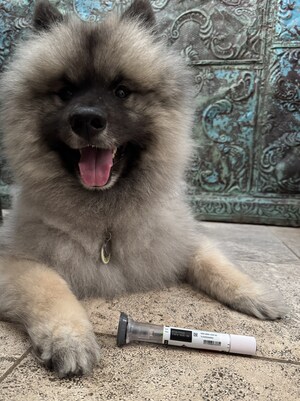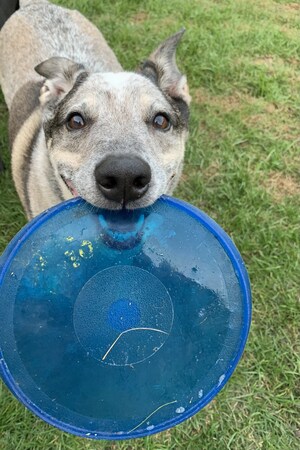Past Poisoning Experience Taught Maryland Residents to Call Pet Poison Helpline Immediately
BALTIMORE, Dec. 6, 2023 /PRNewswire/ -- Mary Mueller and her husband Paul Benson were enjoying a family day of baking after Christmas last year, making salted dough Christmas ornaments with their grandkids' handprints in them that would be tucked away for next year's tree. The holiday works of art were cooling on the counter when Mary noticed they had vanished.
"It was about 6 p.m. when we noticed the ornaments were missing and we knew our dog Shandy was the only one who could have taken them," explained Mary. "At first, we weren't too concerned but then Shandy became very thirsty and started drinking large amounts of water. We knew then we needed to call Pet Poison Helpline."
It wasn't the first time Shandy had ingested something she shouldn't. The playful pooch from Hunt Valley, Maryland, had taken their son's medication bottle into the back yard, chewed off the top, and ingested the pills. This time, they were prepared.
"We called the toxicology experts at Pet Poison Helpline and explained what had happened, the ingredients and number of the ornaments ingested, and how long it had been since Shandy had snuck into the kitchen to eat the ornaments," added Mary.
"While ingredients in a handmade dough ornament may sound safe, many are made with high amounts of salt, and when salt is consumed in this quantity it may cause a risk for hypernatremia," said Dr. Renee Schmid, a senior veterinary toxicologist at Pet Poison Helpline. "Hypernatremia is an electrolyte abnormality characterized by increased sodium concentrations in the blood. This can cause lethargy, excessive thirst, and seizures. Symptoms often include gastrointestinal upset and central nervous system signs. We recommended Shandy be seen by a veterinarian immediately."
"When we arrived at the pet ER," said Mary, "we asked them if they needed the case number. We learned from our last poisoning experience to have that ready when we arrived. Unfortunately, the hospital was very busy, and we had to wait several hours."
Paul and Mary kept checking with the technician who had initially met with them, but due to the high number of animals needing care that evening and Shandy not showing any clinical signs, it was difficult for Shandy to be seen immediately. Calls to Pet Poison Helpline regarding each case are unlimited, so Mary was able to stay in contact with the toxicology experts while waiting for a veterinarian to become available.
"Unfortunately, situations like this arise, as veterinary care facilities often face staffing issues and are diligently working to keep up with the large volume of patients needing their expertise and care," added Dr. Schmid. "That, of course, isn't always reassuring to a pet owner when it is their pet needing treatment."
They were told the medical team was considering whether to induce emesis and shouldn't give Shandy water if they were going to do that procedure. There is a risk of aspiration if vomiting occurs after a large amount of water or other liquid is consumed.
"I called Pet Poison Helpline back, and the person I spoke with was just so wonderful and compassionate," added Mary. "She told me that Shandy couldn't advocate for herself, so it was up to us to speak on her behalf. They encouraged us to let the veterinary staff know the severity of the concern with what Shandy ingested and that timing would be critical in managing her poisoning. With that, I gave the hospital the case number and again asked them to call Pet Poison Helpline to talk about treatment needs. Once they did, it started things rolling. If we had not been able to discuss the seriousness of the ingestion, I think it could have been several more hours before we were seen, and who knows what further damage could have happened."
After emesis was induced, Shandy was given intravenous fluids overnight to minimize the risk of hypernatremia and had lab work evaluated overnight so any indication of hypernatremia could be caught early. Shandy's sodium concentration did begin to rise over the evening but quickly returned to normal with the care she was provided. Fortunately, once Shandy was treated, she made a full recovery. Shandy's case is a great example of how pet owners, veterinary facilities and Pet Poison Helpline work together to help ensure the most positive outcome for pets with poisoning exposures.
Pet Poison Helpline created Toxin Tails to educate the veterinary community and pet lovers on the many types of poisoning dangers facing pets, both in and out of the home. All the pets highlighted in Toxin Tails have been successfully treated for the poisoning and fully recovered.
About Pet Poison Helpline
Pet Poison Helpline, your trusted source for toxicology and pet health advice in times of potential emergency, is available 24 hours, seven days a week for pet owners and veterinary professionals who require assistance treating a potentially poisoned pet. We are an independent, nationally recognized animal poison control center triple licensed by the Boards of Veterinary Medicine, Medicine and Pharmacy providing unmatched professional leadership and expertise. Our veterinarians and board-certified toxicologists provide treatment advice for poisoning cases of all species, including dogs, cats, birds, small mammals, large animals and exotic species. As the most cost-effective option for animal poison control care, Pet Poison Helpline's fee of $85 per incident includes follow-up consultations for the duration of the case. Based in Minneapolis, Pet Poison Helpline is available in North America by calling 800-213-6680. Additional information can be found online at www.petpoisonhelpline.com.
Contact: Dr. Renee Schmid
Pet Poison Helpline
(952) 806-3803
[email protected]
SOURCE Pet Poison Helpline

WANT YOUR COMPANY'S NEWS FEATURED ON PRNEWSWIRE.COM?
Newsrooms &
Influencers
Digital Media
Outlets
Journalists
Opted In






Share this article